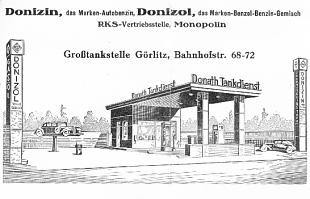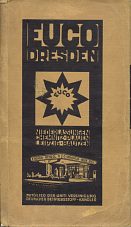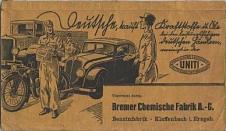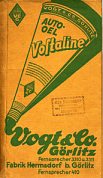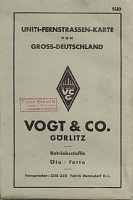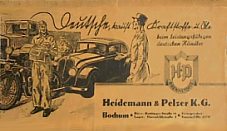UNITI Group brands
Brief History
In the 1920s and 30s the German petrol industry was consolidating into five major groups: BV-Aral, Shell, Esso-Standard, Olex-BP and Leuna (part of the IG-Farben chemicals conglomerate). In order to protect the interests of middle-sized concerns in the German petrol industry, a trade association now named "Uniti Bundesverband Mittelständischer Mineralölunternehmen eV" was established in May 1927.
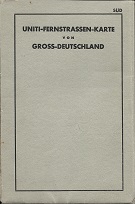 This signed up many of the independents and prior to the 1939-45 war, a surprising number of companies under the Uniti umbrella issued their own road maps; there was co-ordination by Uniti making standard designs available. Initially these were of the atlas with a motorist on the cover shown below; at the end of 1930s though they had been replaced by a single sheet map of Germany at the scale of 1:1,100,000 in plain grey covers, usually printed with the Uniti member's details. Blank cover versions (right) can be infrequently found; there is a corresponding blank area in the bottom right of the map sheet where companies could list stations or products.
This signed up many of the independents and prior to the 1939-45 war, a surprising number of companies under the Uniti umbrella issued their own road maps; there was co-ordination by Uniti making standard designs available. Initially these were of the atlas with a motorist on the cover shown below; at the end of 1930s though they had been replaced by a single sheet map of Germany at the scale of 1:1,100,000 in plain grey covers, usually printed with the Uniti member's details. Blank cover versions (right) can be infrequently found; there is a corresponding blank area in the bottom right of the map sheet where companies could list stations or products.
After the war, some Uniti members were lost in Eastern Germany and disappeared for good. Many of the others signed up over the next 30 years with AVIA, the Swiss-based co-operative brand, or BFT, although remaining as members of Uniti. Other members were subsequently sold to larger companies (eg. DEA and Deltin) or other Uniti members (eg. Rückwarth). Still others remain active under independent brands to this day, including such names as Eller Montan and Westfalen; in all Uniti claims that 3,200 German filling stations (nearly 20%) are still supplied by its members and there are also a handful of sites in its UNITOL colours.
This page will look at some of the old Uniti members, excluding those that now sell AVIA, which have been moved to a special page of German AVIA participants. The names involved are Boie, A. May and Minera.
Donizin (Paul Donath)
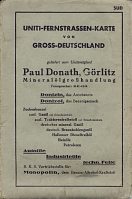
|
Paul Donath, of Görlitz sold Donizin petrol and Donizol mixture, as well as Uniti's Monopolin petrol/alcohol blend. Its service station (right) at 68 Bahnhofstr. survived the war to become a Minol outlet and in 2003 was still selling Elf fuels. |
|
Euco
|
Everth & Co. GmbH was based in Dresden and used the Euco name on its service stations. Four additional depots are named on the cover of this atlas (Leipzig, Plauen, Chemnitz & Bautzen), all in Eastern Germany. Euco appeared to have merged with NITAG in the late 1930s but in any event did not continue after the war. However BP acquired Runo-Everth around 1950, and this may have been from Nitag. |
|
Hudolin (Bremer Chemische Fabrik)
| Many firms used a standard Uniti design, including Bremer Chemische Fabrik AG. Dating back to around 1860, the company was one of the first to refine American crude oil into petrol (gasoline) at a works in Hude bei Bremen. In 1890 it moved to Chemnitz and opened a new oil refinery there in 1898. During the 1930s it marketed products under the name "Hudolin", paying tribute to its original location. |
|
Oelvertrieb Nordhausen
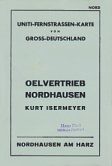
|
Oelvertrieb Nordhausen used at least the later design of Uniti-Fernstrassen-Karte, shown here. It was established in 1924 by Kurt Isermeyer, whose name also appears on the map cover. As its name suggests the company was based at Nordhausen in Thuringia, although it had also opened a branch in Danzig before 1939. After the war the East German Government expropriated the company, and its former owner opened a new operation just 20km away in Herzberg in West Germany. This firm, later incorporated as Isermeyer GmbH, continues to supply a small number of petrol stations and has used the AVIA brand since 1987. |
VC/Vostaline (Vogt & Co.)
|
|
VC appears to have been the petrol brand and Vostaline the name for lubricants from Vogt & Co of Görlitz in SE Germany. The company had its works in the suburb of Hermsdorf, which became part of Poland after the war. Both oil can and map show a diamond lozenge carrying the letters VCG (for Vogt Co Görlitz), but inside the map advertises VC-Benzin and VC-Diesel from a list of four filling stations (tankstellen). There were probably additional dealers or single pump zapfstellen. The later sheet map by Striztke & Rothe shows that it was part of Uniti. |
|
Maps from Other Brands:
Arenol, Brennag, Espolin, Gäbler + Mann, H&P, Olus, Carl Vogelsang & Anton Willer
The companies represented here were all based in Eastern Germany and so it can be presumed that their operations were nationalised in the late 1940s, assuming that they survived the War.
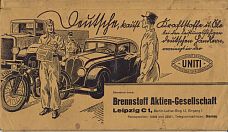 |
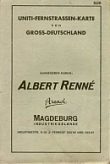 |
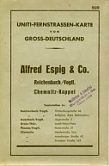 |
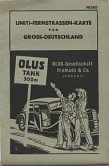 |
 |
Brennstoff was based at Leipzig and in the mid-1930s used the standard UNITI atlas design. After it moved to the simpler design it advertised itself as Brennag for fuels, filling stations and oils, although the sub-branding "Heros" was also used on oils and "Redal" and "Redalin" for motor spirit. To add to this confusing mix of names, the corporate name at this time appears to have been Brennstoff Handels-Gesellschaft Böhme & Riemann. (One can surmise that Redal comes from Riemann.) 21 tankstelle locations are listed, mainly in Leipzig and Halle, where the company also maintained a sales office. |
The simpler Uniti-Fernstrassen-Karte sheet maps can tentatively be dated to around 1938 and are shown at a slightly smaller scale than other maps on this website. They were issued by Albert Renné of Magdeburg which used the Arenol name, and by Alfred Espig & Co. Espig list seven tankstellen (filling stations): four supplied from its depot in Reichenbach (Vogtland) and three in Chemnitz. However, the cover bears the stamp of another dealer, in Burgstädt, suggesting that it also supplied numerous smaller zapfstellen (streetside pumps). Espig used the brand names Espolin for its petrol and Espol for its petrol/oil (two-stoke) mix, as well as selling Uniti's Unitol lubricants. Olus was the name used by Hromada & Co. of Leipzig which operated just 27 zapfstellen and is unlikely to have survived the war.
|
|
H&P (Heidemann & Pelzer) |
Among the other names (not illustrated) that can be found on the same design of road atlas is Carl Vogelsang of Pritzwalk, a town about 100km NW of Berlin. Carl Vogelsang Mineralöle was owned from the mid-1920s by Hermann Vogelsang until 1945 when it was expropriated by the new Communist authorities. After Hermann Vogelsang was able to prove that he had no Nazi sympathies and had helped a Jewish friend, he was allowed to regain control of the company, but this did not fit in easily with the new regime in Eastern Germany. Further unfounded charges were planned, which led to him losing control and escaping to the West in 1953. He re-entered the oil business by establishing a new small company "Hermann Vogelsang Mineralöl-Transporte" in Hamburg in 1956, but this was sold in the 1970s.
Anton Willer, Treibstoffgrosshandlung of Kiel, was established in 1934 and initially operated a large Boie-branded filling station at Herzog-Friedrich-Str 1-9, listed on a mid-1930s Boie atlas. However Anton Willer appears to have split from Boie to sell its own or unbranded fuel as by 1938/9 it issued a Uniti sheet map in its own name with grey covers and no illustration or logo. In 1952 Willer started distributing DEA branded petrol, and continued with that company for over 50 years (although from 1968-88 the Texaco name was used instead). When Shell bought out DEA in 2003, Willer expanded its chain taking on surplus DEA outlets and initially started switching its locations to a new Dexx brand; however in August of the same year it signed up with Tamoil to distribute the latter's HEM brand. Anton Willer GmbH is still owned by a descendant of its founder and now supplies around 33 locations in Schleswig-Holstein, mainly under its own Willer bft identity, but with several Aral sites, and a very few stations selling Esso, Shell, DEXX or unbranded fuel.
The later Uniti type of sheet map can also be found for Gäbler + Mann of Leipzig, although this firm may have concentrated on lubricants.
For some post-war Uniti issues, please follow these link to Uniti (generic), GD (Didillon) and Homburg, and for maps from German independents of the 1930s not apparently associated with Uniti, please follow this link to Milag and Wiol. A full list of German Independent brands known to have issued maps is included on the Freie-T/Uniti page.
Some images on this page are courtesy of Jörg Schimanek and Wilhelm Feuer.
Text and layout © Ian Byrne, 2000-17
All original copyrights in logos and map extracts and images are acknowledged and images are included on this site for identification purposes only.

